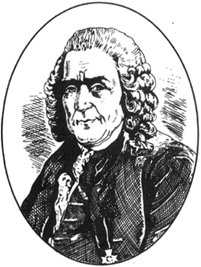Carolus Linnaeus
 |
| Figure 23-1 Carolus Linnaeus (1707-1778), creator of the binomial system of naming plants. (Illustration by Donna Mariano.) |
Carolus Linnaeus (1707-1778) is considered the father of our modem system of naming plants. He is assigned credit for devitshine gb inomial system of naming plants and animals. The scientific name of a plant is its genus name followed by its species name, and the binomial system requires that both names be either printed in italics or underlined. As an example, consider the shrub Euonymus europueus. The value of the scientific name is quickly appreciated when common names are known. This one plant, for instance, is variously known as arrow-beam, prick-timber, prickwood, cat-tree, pegwood, pincushion-shrub, skiver-wood, witchwood, louseberry, butcher’s prick tree, gatten tree, and spindle tree. Obviously, it would be well to abide by scientific names.
Present dayc oncerns are to classify plantosn the basis of kinship, putting together those that have a common evolutionary origin. This was not Linnaeus’s concern. His arrangement divided the plant kingdom into two groups: the Cryptogamia and the Phaenerogamia. Cryptogamia literally means “hidden marriage,” Phaenerogamia, “visible marriage.” The latter includes the flowering .plants. Cryptogams, such as mosses and ferns, have inconspicuous sex cells. The system, while entirely artificial, was useful.
The organisms discussed thus far in this text live in water or moist places (algae) and are saprophytic or parasitic (fungi), or symbiotic (lichens). In tracing from the most primitive (the blue-green algae) to somewhat more advanced forms, a significant change from prokaryotic to eukaryotic was noted. In upcoming chapters, we shall discuss plants that have achieved another profound change: emergence onto land. Among the variables that contributed to this change was the development of vascular (conducting) tissues. Development of vascular tissues, however, was neither the deciding nor the only and certainly not the first requirement for life on land. The mosses and liverworts, for example, have achieved so me level of change without developing vascular tissues. Land plants also evolved structural modifications against excessive water loss, an altered method of gas exchange, supporting tissues, and, over time, new methods of transferring sperm to egg. Yet even the most advanced plants have not completely resolved all the hazards of life on land.




